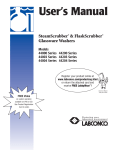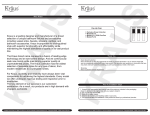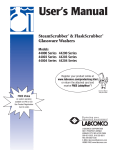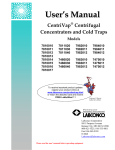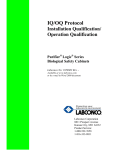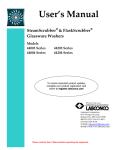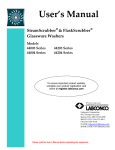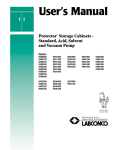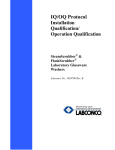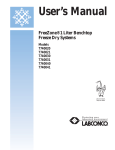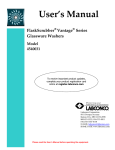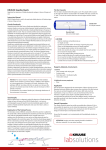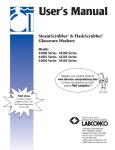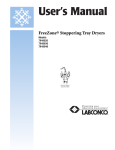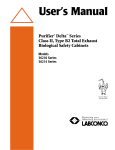Download User`s Manual
Transcript
User’s Manual SteamScrubber® & FlaskScrubber® Glassware Washers Models 44000 Series 44200 Series 44003 Series 44203 Series 44004 Series 44204 Series Register your product online at www.labconco.com/productreg.html or return the attached card and receive FREE LabbyWear™! Labconco’s Mascot, Labby the LABster Form 45036 Revision C, ECO 9873 LABCONCO CORPORATION 8811 PROSPECT AVENUE KANSAS CITY, MO 64132-2696 800-821-5525, 816-333-8811 FAX 816-363-0130 E-MAIL [email protected] HOME PAGE www.labconco.com Copyright Information Copyright © 1998 Labconco Corporation. All rights reserved. Labconco Corporation 8811 Prospect Avenue Kansas City, Missouri 64132 The information contained in this manual and the accompanying product are copyrighted and all rights are reserved by Labconco Corporation. Labconco Corporation reserves the right to make periodic design changes without obligation to notify any person or entity of such change. FlaskScrubber® and SteamScrubber® are registered trademarks of Labconco Corporation. Warranty Labconco Corporation warrants products of its manufacture for one year, from receipt of equipment by the purchaser, against defects in materials and workmanship. This limited warranty covers parts and labor but not transportation and insurance charges. In the event of a warranty claim, contact Labconco or the dealer who sold you the product. If the cause is determined to be a manufacturing fault, the dealer or Labconco Corporation will repair or replace all defective parts to restore the unit to operation. Under no circumstances shall Labconco Corporation be liable for indirect, consequential, or special damages of any kind. This statement of warranty may be altered by a specific published amendment. No individual has authorization to alter the provisions of this warranty policy or its amendments. Lamps are not covered by this warranty. Damage due to corrosion or accidental breakage is also not covered. Limitation of Liability The disposal and/or emission of substances used in connection with this equipment may be governed by various federal, state, or local regulations. All users of this equipment are required to become familiar with any regulations that apply in the user’s area concerning the dumping of waste materials in or upon water, land, or air and to comply with such regulations. Labconco Corporation is held harmless with respect to user’s compliance with such regulations. Contacting Labconco Corporation ☞ If you have questions that are not addressed in this manual, or if you need technical assistance, contact Labconco’s Customer Service Department or Labconco’s Product Service Department at 1-800-821-5525 or 1-816-333-8811, between the hours of 7:00 a.m. and 6:00 p.m., Central Standard Time. Visit Labconco’s web site at: http://www.labconco.com or email Labconco at: [email protected]. Part #45036, Rev. D ECO A577 TABLE OF CONTENTS CHAPTER 1: INTRODUCTION About This Manual Typographical Conventions Your Next Step 1 2 3 4 CHAPTER 2: PREREQUISITES Hot Water Requirements Purified Water Requirements Electrical Requirements Drain Requirements Space Requirements Your Next Step 5 6 6 7 8 9 9 CHAPTER 3: GETTING STARTED Unpacking Your Glassware Washer Washer Components Removing the Shipping Skid Setting Up Your Washer Installing the Casters or Leveling Feet Leveling the Washer Centering the Washer Door Attaching the Washer to the Countertop Connecting the Water Supplies Connecting the Hot Water Connecting the Purified Water Supply Installing Faucet Adapters Attaching the Hose-End Coupling Connecting the Drain Hose Connecting the Power Supply Testing Your Washer Connecting the Hose-End Coupling Running the Diagnostics Disconnecting the Hose-End Coupling Your Next Step 11 12 13 15 15 15 18 20 20 21 21 23 26 27 27 30 32 33 33 35 36 CHAPTER 4: USING YOUR WASHER Arranging the Washer Racks The SteamScrubber Racks Lowering the Washer Arm and Top Rack The FlaskScrubber Racks Loading Glassware into the FlaskScrubber The Detergent Dispenser Filling the Neutralizing Acid Dispenser Selecting an Operating Cycle Programming and Starting a Wash Cycle Interrupting a Wash Cycle 37 37 38 38 41 43 45 47 47 48 50 CHAPTER 5: MAINTAINING YOUR WASHER Maintaining the Stainless Steel Interior Maintaining the Air Gap Maintaining the Water Fill Valve Maintaining the Overflow Dome Replacing the Washer Light Bulb Removing the Washer Top, Back, and Side Panels Cleaning the Sump Filter Screen 51 51 53 53 54 56 57 58 CHAPTER 6: MODIFYING YOUR WASHER Disconnecting the Purified Water Pump FlaskScrubber Options Installing Pipet Inserts in a FlaskScrubber Installing the Adjustable-Height Top Rack 59 59 60 61 63 CHAPTER 7: TROUBLESHOOTING 67 APPENDIX A: FLASKSCRUBBER AND STEAMSCRUBBER COMPONENTS 72 APPENDIX B: GLASSWARE WASHER DIMENSIONS 77 APPENDIX C: GLASSWARE WASHER SPECIFICATIONS 83 APPENDIX D: GLASSWARE WASHER ACCESSORIES FlaskScrubber Accessories SteamScrubber Accessories Expendables 89 89 92 95 INDEX 97 CHAPTER 1 INTRODUCTION Congratulations on your purchase of a Labconco Glassware Washer. Labconco manufactures two types of Glassware Washers, the SteamScrubber® and the FlaskScrubber®. Each of these washers is available in a Mobile, Undercounter, and Freestanding model. Each washer model is available in 115V or 230V, and with or without a window in the door. Your Labconco Glassware Washer is designed and manufactured to thoroughly clean your laboratory glassware and accessories. Using the soft-touch control panel, you can select pre-programmed wash cycles or program customized wash cycles to facilitate your individual requirements. The Glassware Washer Liquid Crystal Display (LCD) identifies the cycle selected and details about the cycle. Models with a window and light in the door allow you to visually monitor the operation of your washer. Option switches for steaming and using purified water for the final rinses allow you to choose the best conditions for cleaning your glassware. Product Service 1-800-522-7658 1 Chapter 1: Introduction About This Manual This manual is designed to help you learn how to install, use, and maintain your Glassware Washer. Instructions for performing routine maintenance and making minor modifications to your washer are also included. Chapter 1: Introduction provides a brief overview of the Glassware Washer, explains the organization of the manual, and defines the typographical conventions used in the manual. Chapter 2: Prerequisites explains what you need to do to prepare your site before you install your Glassware Washer. Hot water, purified water, electrical, and drainage requirements are discussed. Chapter 3: Getting Started contains the information you need to properly unpack, inspect, install, and test your Glassware Washer. Chapter 4: Using Your Washer discusses the basic operation of your washer. Information on how to arrange the racks inside your washer, properly position the glassware, fill the detergent dispenser, and select an operating cycle is included. Chapter 5: Maintaining Your Washer explains how to perform routine maintenance on your Glassware Washer. Information on how to safely clean the interior of your washer, maintain the water fill valve, clean the overflow dome, and replace the light bulb is included. Chapter 6: Modifying Your Washer describes how to disconnect the purified water pump, how to install pipet inserts in a FlaskScrubber, and how to install an optional top rack in a FlaskScrubber. 2 Product Service 1-800-522-7658 Chapter 1: Introduction Chapter 7: Troubleshooting contains a table of problems you may encounter while using your Glassware Washer, including the probable causes of the problems, and suggested corrective actions. Appendix A: FlaskScrubber and SteamScrubber Components contains labeled diagrams of all of the components of the Glassware Washers. Appendix B: Glassware Washer Dimensions contains comprehensive diagrams showing all of the dimensions for the Freestanding, Mobile, and Undercounter models of the Glassware Washers. Appendix C: Glassware Washer Specifications contains the program times and water consumption requirements for the Glassware Washers. Wiring diagrams for both the 115V and 230V washers are also included. Appendix D: Glassware Washer Accessories lists the part numbers and descriptions of all of the accessories available for your Glassware Washer. Typographical Conventions Recognizing the following typographical conventions will help you understand and use this manual: • • • • Book, chapter, and section titles are shown in italic type (e.g., Chapter 3: Getting Started). Steps required to perform a task are presented in a numbered format. Comments located in the margins provide suggestions, reminders, and references. Critical information is presented in boldface type in paragraphs that are preceded by the exclamation icon. Failure to comply with the information following an exclamation icon may result in injury to the user or permanent damage to your Glassware Washer. Product Service 1-800-522-7658 ! 3 Chapter 1: Introduction ☞ • • F M U Important information is presented in capitalized type in paragraphs that are preceded by the pointer icon. It is imperative that the information contained in these paragraphs be thoroughly read and understood by the user. Information that is specific to a particular model of Glassware Washer is preceded by a letter icon. The F icon indicates the text is specific to the Freestanding washer model. The M icon indicates the text is specific to the Mobile washer model. The U icon indicates the text is specific to the Undercounter washer model. Your Next Step If your Glassware Washer needs to be installed, proceed to Chapter 2: Prerequisites to ensure your installation site meets all of the requirements. Then, go to Chapter 3: Getting Started for instructions on how to install your Glassware Washer and make all of the necessary connections. For information on the operational characteristics of your Glassware Washer, go to Chapter 4: Using Your Washer. If your Glassware Washer is installed and you need to perform routine maintenance on the washer, proceed to Chapter 5: Maintaining Your Washer. For information on making modifications to the configuration of your washer, go to Chapter 6: Modifying Your Washer. Refer to Chapter 7: Troubleshooting if you are experiencing problems with your Glassware Washer. 4 Product Service 1-800-522-7658 CHAPTER 2 PREREQUISITES Before you install your Glassware Washer, you need to prepare your site for installation. Carefully examine the location where you intend to install your Glassware Washer. You must be certain that the area is level and of solid construction. In addition, a hot water source, a drain, a purified water source (if applicable), and an electrical source must be located near the installation site. Carefully read this chapter to learn: • • • • the hot water source requirements for your installation site. the purified water source requirements for your installation site. the electrical supply requirements for your installation site. the drainage requirements for your installation site. Product Service 1-800-522-7658 5 Chapter 2: Prerequisites Chapter 2: Prerequisites Refer to Appendix C: Glassware Washer Specifications for complete Glassware Washer electrical and environmental conditions, specifications and requirements. Hot Water Requirements An existing hot water supply may be used as the hot water source for your Glassware Washer. However, the washer requires the inlet water temperature to be greater than 120°F (49°C) to fully activate powdered detergents and raise the glassware temperatures to achieve fast and complete drying. For ultimate washer performance, a hot water inlet temperature setting of 150°F (66°C) is recommended. Water pressure must be between 20 – 120 psi (138 - 827 kPa) at the washer and provide a minimum of 1.25 gallons (4.7 liters) per minute flow rate. A shut-off valve should be installed in the water supply line plumbed to the washer. The hot water inlet valve on the Glassware Washer is equipped with a female 3/8 NPT fitting. Purified Water Requirements Pressurization is not required for the purified water source. If you intend to use purified water for the final rinse cycle, a purified water supply is required. The washer can be connected to an in-house, pressurized, purified water tap; a water purification system; or a purified water container. The purified water system must be provided with supply piping of sufficient size to permit at least 1.25 gallons (4.7 liters) per minute of flow (½" internal diameter (ID) minimum pipe is recommended). The purified water inlet valve on your washer is equipped with a plastic hose barb connection to accommodate ¾" (2 cm) ID flexible plastic or rubber hose. Use a spring or band hose clamp to secure the hose to the hose barb connection. The hose barb connection may be removed from the valve to expose a male ¾" - 11-1/2 NH hose coupling. A rigid plastic, tin- 6 Product Service 1-800-522-7658 Chapter 2: Prerequisites lined, or stainless steel tubing and fitting can be connected to the washer fitting. ! All connections on the purified water system must be airtight so that the washer pump is not allowed to pull air instead of water. If the purified water is stored in a carboy, at least 5 gallons (18.9 liters) must be available for each wash cycle. If all 5 gallons are not available at the start of a wash cycle, but instead are produced concurrently with the wash cycle, the production rate must permit at least 1.25 gallons (4.7 liters) per minute to be delivered to the washer. In addition, all 5 gallons (18.9 liters) must be made available over a 5-minute period. Electrical Requirements If your Glassware Washer is an Undercounter or Freestanding model, it should be hard-wired directly into a junction box using conduit. A 20 Amp circuit breaker or fuse is required for models rated at 115V (60 Hz) or 230V (50/60 Hz). If your Glassware Washer is a Mobile model, a dedicated electrical outlet is required. A 20 Amp circuit breaker or fuse is required for models rated at 115V (60 Hz) or 230V (50/60 Hz). 115V models are equipped with a 20 Amp NEMA 5-20P plug. 230V models are equipped with a 15 Amp NEMA 6-15P plug. It may be necessary to remove the plug and install a different plug to match the available receptacle. Product Service 1-800-522-7658 U F M 7 Chapter 2: Prerequisites Chapter 2: Prerequisites Drain Requirements U F The Glassware Washer drain hose connects to a fitting on the rear side of the pump/motor assembly. The drain hose is installed at the factory prior to shipment. The hose provides a flexible coupling to the building drain piping and can be secured with a spring or band hose clamp. (A band hose clamp is provided with the washer.) U F Tubing or pipe, ½" (1.3 cm) ID or larger, should be provided for the building drain. The use of an air gap is strongly recommended to prevent siphoning of wastewater into the washer. ☞ M 8 DO NOT REDUCE THE SIZE OF THE DRAIN PLUMBING. Mobile models drain into a sink through a hose assembly that attaches to the faucet. Product Service 1-800-522-7658 Chapter 2: Prerequisites Space Requirements If your Glassware Washer is an Undercounter model, you must ensure the undercounter opening is the proper size to accommodate the washer. The dimensions for the Undercounter washer are shown below in Figure 2-2. U Figure 2-2 49.0" 124.3 cm 26.4" 67.1 cm 33.4" 84.8 cm 1 3 .8 '' 34.3" 87.1 cm MIN. 36.3" 92.1 cm 6 .3 '' MAX 2.7" 24.0" 60.9 cm 6.8 cm 3.3" 8.4 cm Your Next Step After you have determined that the location for your Glassware Washer accommodates the installation and operational requirements of your washer, you are ready to unpack and install your washer. Proceed to Chapter 3: Getting Started. Product Service 1-800-522-7658 9 Chapter 2: Prerequisites Chapter 2: Prerequisites 10 Product Service 1-800-522-7658 CHAPTER 3 GETTING STARTED Now that the site for your Glassware Washer is properly prepared, you are ready to unpack, inspect, install, and test your washer. Read this chapter to learn how to: • • • • • • unpack and move your washer. set up your washer. connect the hot water and purified water sources for your washer. connect the electrical supply source to your washer. properly drain your washer. perform set-up diagnostics on your washer. Depending upon which model of washer you are installing, you may need common plumbing and electrical installation tools in addition to a 9/16" wrench, a flat-blade screwdriver, a phillips screwdriver, and a carpenter level to complete the instructions in this chapter. ! The Glassware Washer weighs over 70 lbs. (33 Kg). The carton allows for lifting with a mechanical lift truck or hand truck. If you must lift the washer manually, use at least two (2) persons and follow safe-lifting guidelines. Product Service 1-800-522-7658 11 Chapter 2: Prerequisites Chapter 3: Getting Started Unpacking Your Glassware Washer The United States Interstate Commerce Commission rules require that claims be filed with the delivery carrier within fifteen (15) days of delivery. Carefully unpack your Glassware Washer and inspect the washer for damage that may have occurred in transit. If your washer is damaged, notify the delivery carrier immediately and retain the entire shipment intact for inspection by the carrier. ☞ ☞ ☞ DO NOT RETURN GOODS WITHOUT THE PRIOR AUTHORIZATION OF LABCONCO. UNAUTHORIZED RETURNS WILL NOT BE ACCEPTED. IF YOUR WASHER WAS DAMAGED IN TRANSIT, YOU MUST FILE A CLAIM DIRECTLY WITH THE FREIGHT CARRIER. LABCONCO CORPORATION AND ITS DEALERS ARE NOT RESPONSIBLE FOR SHIPPING DAMAGES. BE CERTAIN TO REMOVE ALL PACKAGING MATERIALS, DETERGENT SAMPLES AND ANY MATERIALS THAT ARE NOT AN INTEGRAL COMPONENT OF THE GLASSWARE WASHER FROM THE INSIDE OF THE WASHER PRIOR TO INSTALLING THE WASHER. Do not discard the carton or packing material for your washer until you have checked all of the components and installed and tested the washer. Do not remove the washer from its shipping skid until it is ready to be placed into its final location. Move the washer by placing a flat, low dolly under the shipping skid. 12 Product Service 1-800-522-7658 Chapter 3: Getting Started Washer Components As previously mentioned, Labconco manufactures two types of Glassware Washers, the SteamScrubber and the FlaskScrubber. Each of these washers is available in a Mobile, Undercounter, and Freestanding model. Each washer model is available in 115V or 230V, and with or without a window. The different washer models require different assembly components. Locate the model of washer you received in the following group of tables. Verify that the components listed are present and undamaged. Catalog # Washer Description 44000-00 44000-01 44000-10 44000-11 SteamScrubber Mobile – 115 V SteamScrubber Mobile – 230 V SteamScrubber Mobile – 115 V with window SteamScrubber Mobile – 230 V with window SteamScrubber Mobile Models Plus the Following: Part # Component Description 44882-01 45036-00 44222-00 44056-00 44057-00 Four (4) Casters User Manual Three (3) ounces of LabSolutions Detergent (with MSDS) One (1) Aerator Adapter One (1) Adapter Fitting Catalog # Washer Description 44003-00 44003-01 44003-10 44003-11 SteamScrubber Undercounter – 115 V SteamScrubber Undercounter – 230 V SteamScrubber Undercounter – 115 V with window SteamScrubber Undercounter – 230 V with window SteamScrubber Undercounter Models Plus the Following: Part # Component Description 18798-01 45036-00 44629-00 14888-00 44222-00 Four (4) Leveling Feet User Manual Two (2) Screws One (1) Clamp Three (3) ounces LabSolutions Detergent (with MSDS) Catalog # Washer Description 44004-00 44004-01 44004-10 44004-11 SteamScrubber Freestanding – 115 V SteamScrubber Freestanding – 230 V SteamScrubber Freestanding – 115 V with window SteamScrubber Freestanding – 230 V with window Product Service 1-800-522-7658 SteamScrubber Freestanding Models 13 Chapter 2: Prerequisites Chapter 3: Getting Started Plus the Following: Part # Component Description 18798-01 45036-00 44680-00 14888-00 44222-00 FlaskScrubber Mobile Models Four (4) Leveling Feet User Manual One (1) Hole Plug One (1) Clamp Three (3) ounces LabSolutions Detergent (with MSDS) Catalog # Washer Description 44200-00 44200-01 44200-10 44200-11 FlaskScrubber Mobile – 115 V FlaskScrubber Mobile – 230 V FlaskScrubber Mobile – 115 V with window FlaskScrubber Mobile – 230 V with window Plus the Following: Part # Component Description 44882-01 45036-00 44222-00 44056-00 44057-00 FlaskScrubber Undercounter Models Four (4) Casters User Manual Three (3) ounces LabSolutions Detergent (with MSDS) One (1) Aerator Adapter One (1) Adapter Fitting Catalog # Washer Description 44203-00 44203-01 44203-10 44203-11 FlaskScrubber Undercounter – 115 V FlaskScrubber Undercounter – 230 V FlaskScrubber Undercounter – 115 V with window FlaskScrubber Undercounter – 230 V with window Plus the Following: Part # Component Description 18798-01 45036-00 44629-00 14888-00 44222-00 FlaskScrubber Freestanding Models Four (4) Leveling Feet User Manual Two (2) Screws One (1) Clamp Three (3) ounces LabSolutions Detergent (with MSDS) Catalog # Washer Description 44204-00 44204-01 44204-10 44204-11 FlaskScrubber Freestanding – 115 V FlaskScrubber Freestanding – 230 V FlaskScrubber Freestanding – 115 V with window FlaskScrubber Freestanding – 230 V with window Plus the Following: Part # Component Description 18798-01 45036-00 44680-00 14888-00 44222-00 14 Four (4) Leveling Feet User Manual One (1) Hole Plug One (1) Clamp Three (3) ounces LabSolutions Detergent (with MSDS) Product Service 1-800-522-7658 Chapter 3: Getting Started If you did not receive one or more of the components listed for your washer, or if any of the components are damaged, contact Labconco Corporation immediately for further instructions. Removing the Shipping Skid After you verify the washer components, move your washer to the location where you want to install it. Then, follow the steps listed below to remove the shipping skid from your washer. Move the washer by placing a flat, low dolly under the shipping skid. To remove the shipping skid: 1. Make certain any loose items inside the washer have been removed. 2. Gently place the washer on its back, positioning the washer on the shipping carton or other cushioning material. 3. Remove the four screws fastening the skid to the washer. Retain the shipping skid until you test the various features of the washer. Setting Up Your Washer After you remove the skid from your washer, you must install either casters or leveling feet on the bottom of the washer. If you have an Undercounter or Freestanding model, then you must level the washer and center the washer door. If you have an Undercounter model, you must also attach the washer to the countertop or worksurface. Installing the Casters or Leveling Feet If you have the Mobile model of the SteamScrubber or FlaskScrubber washer, the washer must sit on a level floor. Refer to Figure 3-1 and follow the steps below to install the casters on your washer. Product Service 1-800-522-7658 M 15 Chapter 2: Prerequisites Chapter 3: Getting Started To install the washer casters: 1. Locate the holes on the bottom of the washer where the four skid-fastening screws were previously attached. 2. Thread the four casters into these holes until the casters fit tightly. 3. Carefully move the washer into an upright position. Be careful to distribute the weight evenly on the casters when setting the washer upright. Figure 3-1 Bottom of washer 16 Product Service 1-800-522-7658 Chapter 3: Getting Started If you have the Undercounter or Freestanding model of the SteamScrubber or FlaskScrubber washer, refer to Figure 3-2 and follow the steps detailed below to install the leveling feet on your washer. U F To install the washer leveling feet: 1. Locate the holes on the bottom of the washer where the four skid-fastening screws were previously attached. 2. Thread the four leveling feet into the holes. 3. Carefully move the washer into an upright position. Be careful to distribute the weight evenly on the leveling feet when setting the washer upright. Figure 3-2 Bottom of washer Product Service 1-800-522-7658 17 Chapter 2: Prerequisites Chapter 3: Getting Started Leveling the Washer F If you have the Freestanding model of the SteamScrubber or FlaskScrubber Glassware Washer, after you have installed the leveling feet, you must level the washer by adjusting the leveling feet. To level the washer: 1. Position the washer in its final installation site. 2. Place a carpenter level on the washer in the positions shown in Figure 3-3. Figure 3-3 Position the level in both directions to ensure the washer is level front-to-back and side-to-side. 3. Turn the four leveling feet, as needed, to level the washer. A leveling foot is illustrated in Figure 3-4. 18 Product Service 1-800-522-7658 Chapter 3: Getting Started Figure 3-4 Turn the leveling foot clockwise to lower the washer and counterclockwise to raise the washer. Leveling foot If you have the Undercounter model washer, you may level it side-to-side by placing a short level on the inside top edge of the door. Refer to Figure 3-5 for the placement of the level on the washer. U Figure 3-5 Position the level as shown to level the Undercounter model washer from side-to-side. Product Service 1-800-522-7658 19 Chapter 2: Prerequisites Chapter 3: Getting Started Centering the Washer Door When the washer is level, check the operation of the washer door for alignment with the washer tank. If the door is not centered in the opening, you must center the door by adjusting the corresponding leveling foot. (For example, if the door hits the right side of the tank, raise the right front corner of the washer. If the door hits the left side of the tank, raise the left front corner of the washer.) Attaching the Washer to the Countertop U If you have an Undercounter Glassware Washer, two screws have been provided to attach the front of the washer to the underside of the countertop or worksurface. After the washer is leveled in its final position and the washer door is properly centered, install the two screws as shown in Figure 3-6 to stabilize the unit and prevent it from moving. Figure 3-6 Insert the screws through the holes in the clips in the front corners of the washer and secure the screws to the countertop. 20 Product Service 1-800-522-7658 Chapter 3: Getting Started Connecting the Water Supplies A hot water supply must be attached to your Glassware Washer. If you need purified water for the final rinse cycle, then you must also connect a purified water source to your washer. Connecting the Hot Water To prevent valve clogging, flush all of the hot water lines for your hot water supply source prior to connecting the washer to the water lines. The water supply valve to which the hot water supply must be connected is located in the lower right front corner of the washer. The lower panel of the washer must be removed to access the valve. To remove the panel, refer to Figure 3-7 and the instructions below. U F Before continuing with this section, be certain your hot water source meets the requirements discussed in Hot Water Requirements in Chapter 2: Prerequisites. To remove the lower panel: 1. Remove the two screws at the bottom of the lower panel of your washer. 2. Remove the panel by lifting slightly and pulling out. Figure 3-7 Lift the panel slightly before pulling out to disengage the panel “lip.” Screw Product Service 1-800-522-7658 21 Chapter 2: Prerequisites Chapter 3: Getting Started After you remove the lower panel, you are ready to connect the hot water source. Refer to Figure 3-8 and follow the instructions below to connect the hot water. ☞ YOU MUST PROVIDE THE PLUMBING FITTINGS AND COMPONENTS NEEDED TO CONNECT THE HOT WATER SUPPLY SOURCE. THE WASHER HOT WATER SUPPLY VALVE IS EQUIPPED WITH A 3/8" FEMALE NPT FITTING. 3/8" TUBING OR LARGER IS RECOMMENDED FOR THE SUPPLY PLUMBING. To connect the hot water supply: 1. Be certain the hot water supply piping has been thoroughly flushed prior to connecting it to the washer. Debris in the piping can clog the washer valve. 2. Make the necessary plumbing connections to properly connect the hot water supply to the washer. Figure 3-8 Customersupplied plumbing Washer hot water valve 22 Product Service 1-800-522-7658 Chapter 3: Getting Started Connecting the Purified Water Supply To prevent valve and pump clogging, flush all of the water lines for your purified water supply source prior to connecting the washer to the water lines. The water supply valve to which the purified water supply must be connected is located in the lower right front corner of the washer. The lower panel of the washer must be removed to access the valve. Refer to Figure 3-9 and follow the instructions below to connect the purified water source. ☞ Before continuing with this section, be certain your purified water source meets the requirements discussed in Purified Water Requirements in Chapter 2: Prerequisites. THE PURIFIED WATER INLET VALVE IS EQUIPPED WITH A PLASTIC HOSE BARB CONNECTION TO ACCOMMODATE ¾" (2 CM) ID FLEXIBLE PLASTIC OR RUBBER HOSE. THE HOSE CONNECTION MAY BE REMOVED FROM THE VALVE TO EXPOSE A MALE 3/4" - 11-1/2 NH HOSE COUPLING. RIGID PLASTIC, TIN-LINED, OR STAINLESS STEEL TUBING AND FITTINGS MAY BE CONNECTED TO THE WASHER FITTING. Figure 3-9 Customersupplied plumbing Hose barb connector supplied with washer Purified water valve Product Service 1-800-522-7658 23 Chapter 2: Prerequisites Chapter 3: Getting Started ☞ M AT LEAST 1.25 GALLONS (4.7 LITERS) PER MINUTE OF PURIFIED WATER FLOW IS REQUIRED. AT LEAST 5 GALLONS OF PURIFIED WATER MUST BE AVAILABLE FOR EACH WASH CYCLE. A ½" ID PIPE IS THE MINIMUM RECOMMENDED. If the washer is a Mobile model and is moved to various locations, and if purified water is used, provisions must be made to use a flexible hose from a source of housepurified water. If a carboy is used, place the carboy on a carboy cart and move it with the washer. Be careful not to let the hose kink or become damaged. To connect the purified water supply: If you do not use purified water during the washer cycle, you may want to disconnect the purified water pump. Refer to the section, Disconnecting the Purified Water Pump in Chapter 6: Modifying Your Washer. 1. Make certain the purified water supply piping has been thoroughly flushed prior to connecting it to the washer. 2. Remove the two screws at the bottom of the lower panel of your washer, as shown in Figure 3-7. 3. Remove the panel by lifting slightly and pulling out. 4. Make the necessary plumbing connections to properly connect the purified water supply to the washer. NOTE: If the purified water source is a carboy, complete steps 5 and 6. 5. Connect the purified water source through either the top or the bottom of the carboy, as illustrated in Figures 3-10 and 3-11. If the purified water supply feeds directly from the carboy top, make certain the hose is submerged under the water line. Attach a weight to the end of the tubing, as shown in Figure 311, to keep it from floating on top of the water and possibly allowing air into the system. 6. Make certain the top of the carboy is vented to permit proper flow from the carboy to the washer. 24 Product Service 1-800-522-7658 Chapter 3: Getting Started Figure 3-10 Open for vent Purified water pump Example of a Bottom Feed Connection Figure 3-11 Clamp weight to hose to keep it submerged. Cut hose into a V configuration for siphoning. Spigot Purified water pump Example of a Top Feed Connection Product Service 1-800-522-7658 25





























